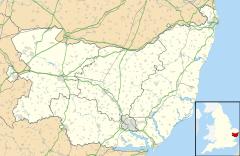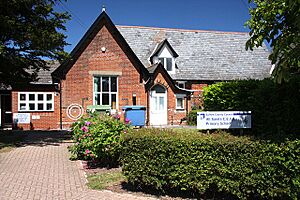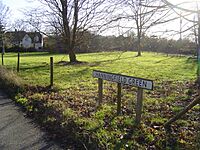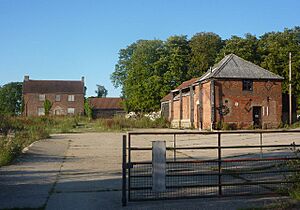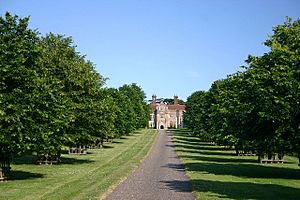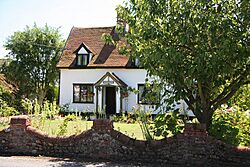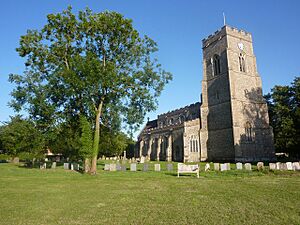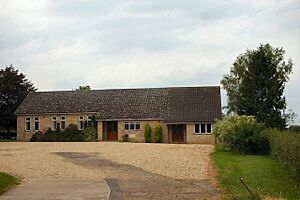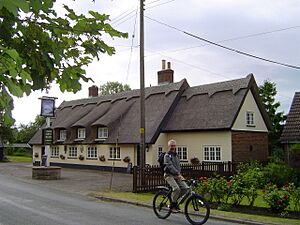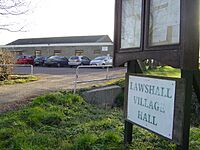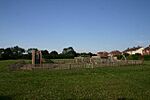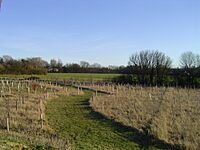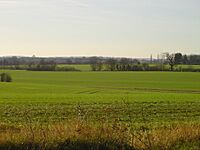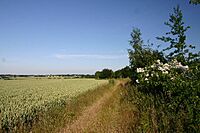Lawshall facts for kids
Quick facts for kids Lawshall |
|
|---|---|
| Village and civil parish | |
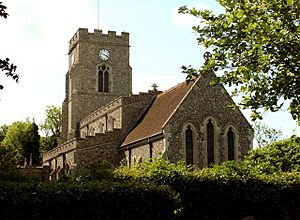 All Saints church, Lawshall |
|
| Population | 968 (Including Ickworth. 2011) |
| District |
|
| Shire county | |
| Region | |
| Country | England |
| Sovereign state | United Kingdom |
| Post town | Bury St Edmunds |
| Postcode district | IP29 |
| EU Parliament | East of England |
Lawshall is a village and civil parish in Suffolk, England. A civil parish is a local government area. Lawshall is located about one mile off the A134 road. This road connects Bury St Edmunds and Sudbury. The village is part of the Babergh area.
Lawshall parish has nine different areas where people live. There are three main settlements: The Street, Lambs Lane, and Bury Road. It also has six smaller hamlets: Audley End, Hanningfield Green, Harrow Green, Hart's Green, Hibb's Green, and Lawshall Green.
Important buildings in Lawshall include All Saints Church and Lawshall Hall. Coldham Hall is also very close to the village. Some of its land is even within the parish. Other key features are Frithy Wood, an Ancient Woodland and a special nature site. There is also The Warbanks, an old historical site.
Contents
What's in a Name?
The village was first called "Hlaw-gesella." This name meant "the shelter or hut on a hill" or "high ground." Over time, the name changed. Early records show it was called "Laushella" in 972. Later, it became "Lawesselam" (1086), "Laveshel" (1095), "Laweshell" (1194), and "Laugesale" (1253).
Lawshall's Story Through Time
Village Layout
Lawshall is spread out, with houses and groups of houses scattered around. The three main parts of the village are The Street, Lambs Lane, and Bury Road. The Street includes the area around the Church and Village School. Lambs Lane includes The Glebe, Shepherds Drive, and Windsor Drive. Bury Road is a long line of houses.
Besides these, there are six smaller hamlets: Audley End, Hanningfield Green, Harrow Green, Hart's Green, Hibb's Green, and Lawshall Green. The area around All Saints Church and the primary school is seen as the village center.
Early Beginnings
The first written record of Lawshall is from around 972 AD. But people likely lived here much earlier. The current village center probably wasn't the first settlement. This is because it didn't have a good water supply. Hanningfield Green might have been the first Bronze Age settlement. Another idea is that it was near the Chad Brook stream.
The oldest signs of people in Lawshall are the Warbanks. These are old earthworks that were built before the Romans arrived. They might have been an early defense system. A Bronze Age sword, dating from 800-600 BC, was found at the Warbanks. This gives us a clue about how old the site might be.
Around 972 AD, a man named Alwinus owned the land. He gave his land to the Ramsey Abbey monastery. This was the first time "Laushella" (Lawshall) was written down. The land stayed with Ramsey Abbey until about 1534.
Medieval Times
Lawshall was mentioned in the Domesday Book in 1086. This book was a survey of England ordered by William the Conqueror. It said that "St Benedict held Lawshall as a Manor." A Manor was a large estate. The record showed 16 villagers, 10 small farmers, and 5 slaves. It also listed animals like horses, cattle, pigs, sheep, and goats. There was also a church.
The Abbot of Ramsey Abbey still controlled the manor in 1269. An agreement from that year shows this. It was about taking care of the family of the tenant of Lawshall Hall. Some names from a 1327 tax list for Lawshall are still seen in place names today. For example, Herbard (Herberts Farm) and Hanningfield (Hanningfield Green).
Tudor and Stuart Eras
After the Dissolution of the Monasteries in 1534, Lawshall Manor was given to John Rither. Then, in 1547, it was sold to Sir William Drury. The Drury family was very important in the area. They had connections with the Royal Family. This might be why Queen Elizabeth I visited Lawshall in 1578.
Queen Elizabeth I visited Henry Drury at Lawshall Hall during her "Royal Progress" tour. This was in August 1578. She traveled from Long Melford and had dinner at Lawshall Hall. Then she went to Hawstead. Imagine how excited the villagers must have been to see the Queen!
In 1563, there was a double wedding in the village. One marriage joined the Catholic Rookwood family and the Protestant Drury family. Thirty years later, Elizabeth Drury of Lawshall was on a list of people who refused to attend Church of England services.
Ambrose Rookwood from Coldham Hall was involved in the Gunpowder Plot. This was a plan to blow up King James I and his Parliament in 1605. Rookwood had many fine horses. He was asked to join the plot because his horses could help them escape quickly. He was arrested in November 1605 and later executed.
A detailed map of Lawshall was made in 1611 for Sir Henry Lee, the Lord of the Manor. It showed the land and houses. Records from the 1600s also include the Hearth Tax of 1674. This listed every house, its owner, and how many fireplaces it had.
Lawshall also had its own gallows and a workhouse. A workhouse was a place where poor people could live and work. In 1776, the workhouse had 20 people living there.
Victorian Era Changes
The 1800s brought big changes to Lawshall. This was due to the Industrial Revolution and new farming methods. The village population changed a lot. In 1801, 554 people lived there. By 1841, it grew to 925. But by 1901, it dropped to 664.
Farming played a big role in these changes. During the Napoleonic Wars, there was a high demand for food. This meant better prices for farmers and a higher birth rate. After the wars, farming struggled until 1834. This caused the population growth to slow down.
Many people faced unemployment. They had to rely on poor relief, which was help for the poor. By 1834, it cost the village £902 a year to support paupers. Village charities also helped. They gave coal and clothes to adults and children who went to Sunday school.
After the tough times, farming became successful again. This was called "High Farming." Farmers made more money by using new methods. They used artificial fertilizers and machines like threshing machines. They also improved land drainage. The population reached its highest point of 925 in 1841, showing the return of good times.
By the late 1800s, Lawshall was mostly self-sufficient. But it also started sending goods outside the village. A horsehair factory, first recorded in 1855, was a major "exporter." There were also rake and hurdle makers. These businesses grew with the arrival of railways. The Long Melford-Bury St Edmunds branch line opened in 1865. This made it easier to transport goods. The line opened for passengers in 1870. This allowed some Lawshall residents to visit London for the first time.
The village had its own mill at Mill Cottage, Golden Lane. An old map from 1611 shows another mill site between Lawshall Hall and Harrow Green.
Twentieth Century
The farming depression ended with the start of the First World War. The war increased demand for goods and food. Many young men from Lawshall went to war, and 24 did not return. The church clock was installed as a memorial to them.
The 20th century brought huge changes. Tractors replaced horses, and cars replaced bicycles. Telephones, radio, and electricity arrived. The look of the village changed a lot. From 1939 to 1945, farming recovered. Farmers cleared hedgerows and trees to grow more crops. Fields that were once about 8 acres are now closer to 40–50 acres.
Starting in the 1940s, the village lost many services. There used to be five pubs, but now only The Swan remains. The Harrow pub closed in 1971. The village also lost shops, the post office, and regular public transport. However, important places like All Saints primary school are still there. The school was almost closed in the late 1980s.
The current village hall was built in the 1960s. It is still a very important place for the community. It replaced an older village hall that was once the horsehair factory. This old hall also served as the school's dining hall.
In June 1991, the village sign was revealed. Its design shows Lawshall's connection to the Abbey of Ramsey. It features the abbey's symbols with two monks. The lower part of the sign shows the coats of arms of the Drury and Hanningfield families. The Drury family bought Lawshall Manor in 1547.
Places to Worship
All Saints Church
This church was built in the 1400s using flint stone. It is a Grade 1 Listed Building. This means it's a very important historical building. It has a tall tower, a main area called the nave, side sections called aisles, and a chancel rebuilt in the 1800s. The church was first mentioned in the Domesday Book.
The church was mostly rebuilt in the mid-1400s. This was thanks to money from the cloth industry. After the Reformation, it became a large place for preaching. In the 1800s, during a time of farming success, the church was greatly restored. This was done by William Butterfield. The rector, Evan Baillie, spent £3,000 of his own money to rebuild parts of the church.
Our Lady Immaculate and St Joseph Catholic Church
The Catholic community of Our Lady Immaculate and St Joseph, also known as Coldham Cottage, started in 1574. At that time, services were held in what is now Coldham Hall. The current church was built in 1870. It is now the oldest Roman Catholic Mission in Suffolk.
Coldham Cottage itself is an old building from the late 1600s or early 1700s. It has a timber frame and a tiled roof. Until 1868, the priest held services in the chapel at Coldham Hall. After the estate was sold, a separate church was built. It used part of the existing house and added an extension. This church is a rare example of continuous Catholic use since at least the 1700s.
After some renovation, there is now a priest living at the cottage. It also offers holiday accommodation for other priests.
Lawshall Evangelical Free Church
Lawshall Evangelical Free Church was started by local Evangelical Christians. They wanted to have their own way of worship. From about 1968, people met in different houses for worship and bible study. A gift from Walter G Waspe helped build a new church. It opened on August 1, 1970.
The first building had a chapel, a small room for the minister, a kitchen, and toilets. More additions were made in 1978, including a hall and new toilets. A baptistry, a pool for baptisms, was also added. In July 1976, the church got its first Pastor, David Bedford-Groom. He led the church part-time for 12 years.
How Lawshall is Governed
Lawshall is part of the Babergh area in Suffolk. There are three levels of local government that manage the village. These are Suffolk County Council, Babergh District Council, and Lawshall Parish Council. The Lawshall Parish Council has 7 elected members who help run the village.
Village Facilities
The Swan Inn
In the 1800s, Lawshall had seven pubs or places that sold beer. Today, only The Swan Inn remains. It's an old building from the 1700s. It has a thatched roof. Inside the pub, there are coins nailed to the wooden beams. Soldiers during World War I used to nail up coins. They would reclaim them when they returned from war. The coins still there remind us of the 24 men from the village who did not come back.
Village Hall
Lawshall Village Hall was built in the 1960s. It replaced an older hall that used to be in The Street. The hall was updated in 2007. A committee manages the Village Hall. They also create a monthly magazine called Round & About Lawshall. This magazine is delivered to every home in the village.
Primary School
Lawshall has one school, All Saints CEVCP Primary School. Children aged 5 to 11 attend this school. It has about 90 students from Lawshall and nearby villages. These include Alpheton, Shimpling, Bridge Street, and Hawstead. The school building was first built in the Victorian era. It was modernized and expanded in 1989. The school also has a special nursery building. This building is shared with Lawshall Pre-School. Older children from Lawshall go to King Edward VI CEVC Upper School in Bury St Edmunds.
Recreation and Open Spaces
There is a recreation ground on Shimping Road. It is used by the Hartest and Coldham Hall Cricket Club. It is also home to the Lawshall Swan Football Club. Brian Talbot, a famous footballer, played there when he was young. In the past, sports were also played near Coldham Hall and behind All Saints Church.
Lawshall also has several open spaces:
- Land between The Glebe and Shepherds Drive: This includes a play area managed by the Lawshall Community Playground Society.
- Land behind Churchill Close: A grassy area used for casual football games.
- Grassland at Hanningfield Green: A meadow now recognized as a County Wildlife Site.
- Grassland at Lawshall Green: A small area of flower-rich grassland.

Bus Services
Lawshall has a bus service. It is run by Mulleys Motorways and supported by Suffolk County Council.
Nature and Wildlife
Lawshall parish has important wildlife areas:
- Woodlands: Part of the Frithy and Chadacre Woods SSSI is in the parish. These are very old woodlands. Frithy Wood is a key wildlife area. Records show Frithy Wood existed in 1545, but its old Saxon name suggests it's much older.
Local community woodlands have been planted as part of the "Forest for Our Children" project. This project covers 9 hectares (about 22 acres) and includes two woods. Crooked Wood was planted in 1993. Golden Wood was planted between 1994 and 2010. This project has inspired other community-owned nature sites across the UK. It also helps with environmental education for schools.
- Grasslands: Suffolk has very few natural grasslands left. But Lawshall and Hanningfield Greens are managed as traditional hay meadows. This means they are cut for hay after the flowers have produced seeds. A small part of All Saints churchyard is also managed this way. Hanningfield Green is a County Wildlife Site. This is because of the many native plants that grow there.
Landscape and Scenery
Lawshall's landscape has different types of scenery:
- Rolling Ancient Farmlands: Most of Lawshall is made up of these lands. They have old fields with irregular shapes. These fields are bordered by large, old hedges. Houses and small hamlets are spread out. There are also old woods on the clay hills. You can see long views across this rolling landscape. Trees in hedges and woods are always a key feature. Over time, some hedges have been removed for farming.
- Ancient Rolling Farmlands: This area is in the east of the parish, between Lawshall Green and the A134 road. It's a rolling landscape with chalky clays. Many fields still have their original, old hedgerows. However, some fields have been combined, and boundaries lost. Farms are large, but mostly owned by the farmers. The trees in the hedges are typically oak, ash, and maple. The landscape is mostly untouched, with winding roads and wide grassy edges.
- Rolling Valley Farmlands: A small area at Audley End is this type of landscape. It has small and medium-sized fields on the valley sides. These fields were created over time as common lands were divided. Fields tend to get larger higher up the valleys. Villages and towns grew here because of the good land for farming. Old woodlands are mostly found on the upper slopes of the valleys.
Historic Buildings
Historic England lists many important buildings in Lawshall. These buildings are protected because of their historical value.
- Grade I
- Church of All Saints
- Grade II*
- Lawshall Hall
- Grade II
- Barfords
- Bowaters and Shepherds Cottage
- Carpenters Cottage
- Church House
- Coldham Cottage and attached Church of Our Lady and St Joseph
- Cottage, Hart's Green
- Dales Farmhouse
- Elm House
- Folly Farm
- Fox Cottage
- Hanningfields Farmhouse
- Hills Farmhouse
- Keepers Cottage
- Little West Farm
- Newhall Cottage
- Newhouse Farmhouse
- Pond Cottage
- Silver Farmhouse
- Street Farmhouse
- Sunnyridge
- Swan Inn
- The Howes
- The Old Post Office
- The Ryes
- The Walnut Trees
- Trees Farmhouse
Local Groups and Clubs
Green Light Trust is a charity focused on the environment and education. They help communities and nature by teaching hands-on skills and planting woodlands.
This is a community group that looks after Golden Wood and Crooked Wood. These are Lawshall's community woodlands. They meet on the last Sunday of every month in Golden Wood.
Lawshall Pre-School is a self-funded charity. It is run by a committee of parents whose children attend the Pre-School.
There are two trusts in the village managed by The Lawshall Trustees:
|
Current clubs:
Former clubs:
|
Population Changes
According to the Office for National Statistics, Lawshall had a population of 935 people in 2001.
| Population growth in Lawshall from 1801 to 1891 | ||||||||||
|---|---|---|---|---|---|---|---|---|---|---|
| Year | 1801 | 1811 | 1821 | 1831 | 1841 | 1851 | 1881 | 1891 | ||
| Population | 554 | 717 | 837 | 885 | 925 | 908 | 799 | 770 | ||
| Source: A Vision of Britain Through Time | ||||||||||
| Population growth in Lawshall from 1901 to 2001 | ||||||||||
|---|---|---|---|---|---|---|---|---|---|---|
| Year | 1901 | 1911 | 1921 | 1931 | 1951 | 1961 | 2001 | |||
| Population | 664 | 656 | 602 | 598 | 516 | 543 | 935 | |||
| Source: A Vision of Britain Through Time | ||||||||||
Famous People from Lawshall
Some well-known people have lived in Lawshall. These include:
- John Brereton, an adventurer.
- John Stearne, a witch-hunter.
- Ambrose Rookwood, who was involved in the Gunpowder Plot.
- David Hart, a political adviser.
- Matthew Vaughn, a film producer and director.
- Claudia Schiffer, a model.
Where Lawshall Is Located
 |
Whepstead | Hawstead | Stanningfield |  |
| Brockley | Cockfield | |||
| Hartest | Shimpling | Shimpling Street |
See also
 In Spanish: Lawshall para niños
In Spanish: Lawshall para niños


